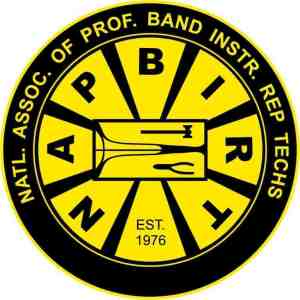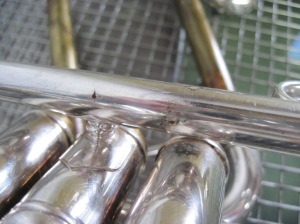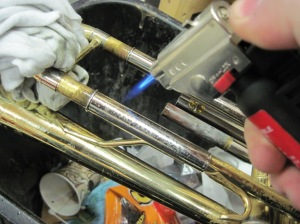There seems to be a fair amount of interest in learning band instrument repair among musicians. Especially with saxophonists…not sure why; maybe because their horns are more mechanically complex than other horns? Anyway, if you happen to be interested in learning the band instrument repair trade, this post is for you!

There are two ways to get into the band instrument repair trade: Going to a repair school or apprenticing. A combination of both is also a possibility.
Repair Schools
If you went to a repair school you would be taught the basics of each instrument. You’ll learn how to do re-pads and adjustments on woodwinds and you’d learn dent work on brass instruments. Those are the fundamentals of repair and the majority of the work you’ll do in an all around shop. Some schools may delve slightly deeper into repair; possibly doing finish work, making parts, or other things.
Repair school programs are no longer than two years and the time you spend actually learning repair varies between schools. Badger State Repair, run by Ed Strege in Wisconsin, is a 9 month program that consists entirely of hands on repair training. At the other schools you have to complete a normal associates degree program that includes math, English, and anything else a normal community college would require you to do to graduate.
When you leave the repair schools, the knowledge you have should be sufficient to get you hired at least somewhere, probably the big chain stores like Sam Ash or Music and Arts. However, without more training and on the job experience, you will be severely limited as a repair tech.
I believe the main reason many people choose repair school is because it is the only option to get started in the trade. Apprenticeships, especially with good repairmen, are extremely hard to come by for a few reasons I’ll explain later. If you can’t get an apprenticeship, then repair school is really your only option.
Repair school information can be found here:
http://www.napbirt.org/mc/page.do?sitePageId=57220&orgId=napbirt
Apprenticing
The other option is being trained by a senior tech in an apprenticeship. In this situation, you would work in a shop under the supervision of a repairman while you learn. Unlike many unionized trades, the band repair business has no set rules or regulations concerning training. This means that whatever you learn, if you get paid, how much you get paid, etc. is entirely up to your boss.
There are a lot of benefits of apprenticing that the repair schools can not offer. For one thing, you actually get to do real work. Whether the horn be a rental or a customers, you are working on an instrument someone will be playing at some point. I think that is a nice morale booster to be able to say, ‘I worked on that horn and someone is playing it now’. When you know someone needs that horn to work, you make sure you do a good job. If it was just some classroom example, who cares if it works or not? No one will ever play it anyway.
Cost is also big factor in learning the trade. To attend the repair program at Badger State Repair it costs $16,000 at last check. That doesn’t include anything other than some basic tools and the actual training; no lodging, no food, no nothing. I don’t know the specifics about the other schools, but assume they are comparable to other community college tuition rates + the cost of your tools. In the cost category, an apprenticeship wins hands down because it’s free and you might even be paid a little while doing it if you’re lucky.
The most important thing about an apprenticeship is that you will be trained one on one. If you find a great repairman to teach you, you can learn much more than any school could teach you in the same period of time. If you’re ready to move onto a new topic, you can because you won’t be held back by classmates who aren’t there yet. Conversely, if you need more time on something, you won’t be rushed. This way, you will learn what you need to and not miss things that you might with a schools schedule.
There’s one major obstacle inherent in training in an apprenticeship: Getting an apprenticeship. Instrument repair technicians are not like car repair technicians; there aren’t thousands and thousands of them, there’s maybe 3-4,000 instrument repairmen on Earth. (you’d think I’d be paid more) And out of those, there are few and far between that are actually worth learning from.
Even if you do find a good repairman, he has to be willing to take on an apprentice! Good repair techs are busy. If they take an apprentice, they lose time repairing and that means lost money. If you turn out to be a good repairman, it’s worth the time for them because now they have a skilled employee they know can do the work to their standards of quality.
Just a closing
Now you should have a fairly good idea about the ways people get started in the band instrument repair trade. As you can probably discern, I’m a big proponent of apprenticeships and not so enthusiastic about the repair schools. I was trained in an apprenticeship but I’ve visited a repair school and have met techs trained in repair schools. In my experience, the apprenticeship is the way to go if you can find one. My next post will talk about ways to find those elusive apprenticeships. If you’re interested, come on back to The Horn Kicker and read it then.
















